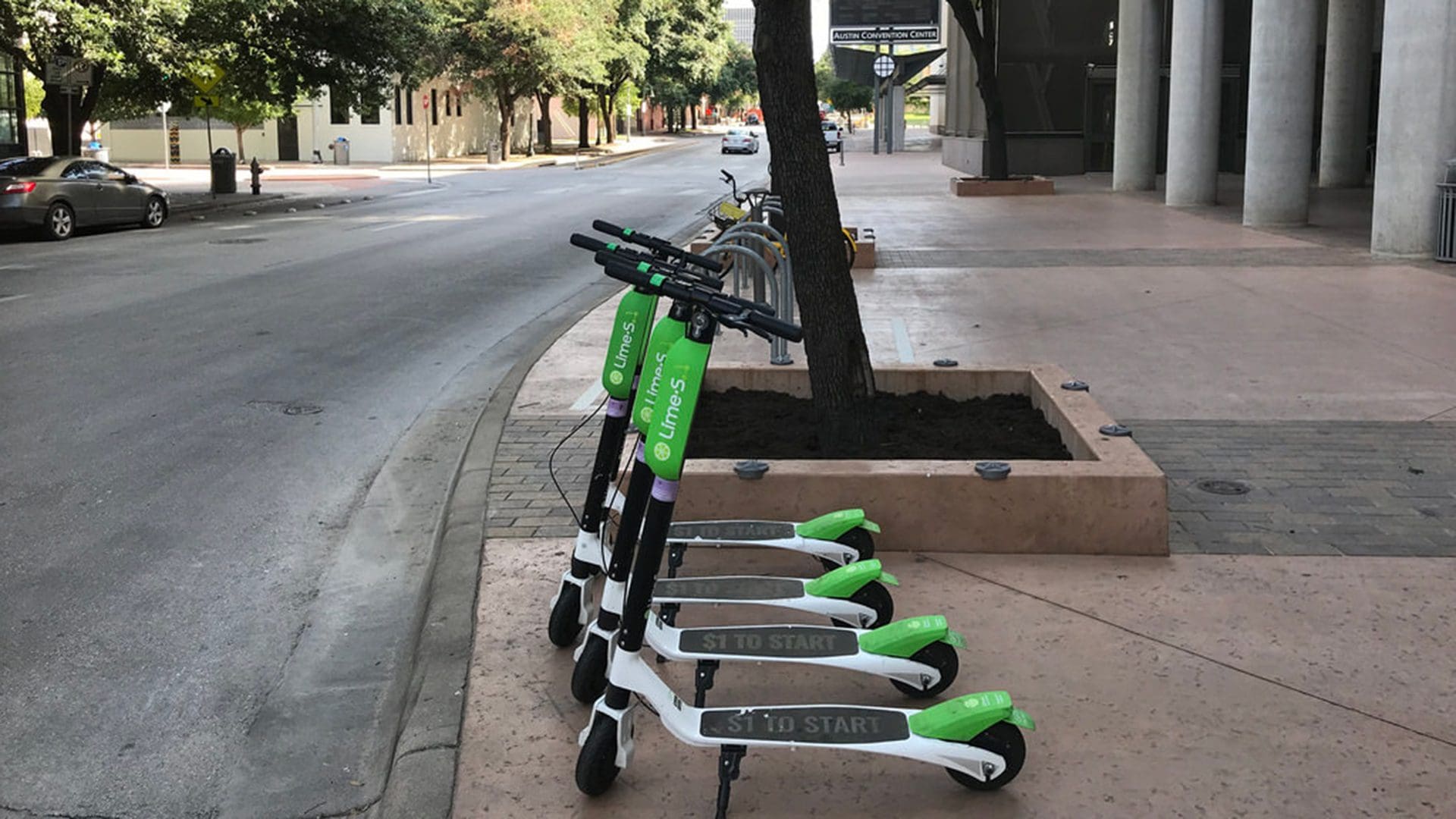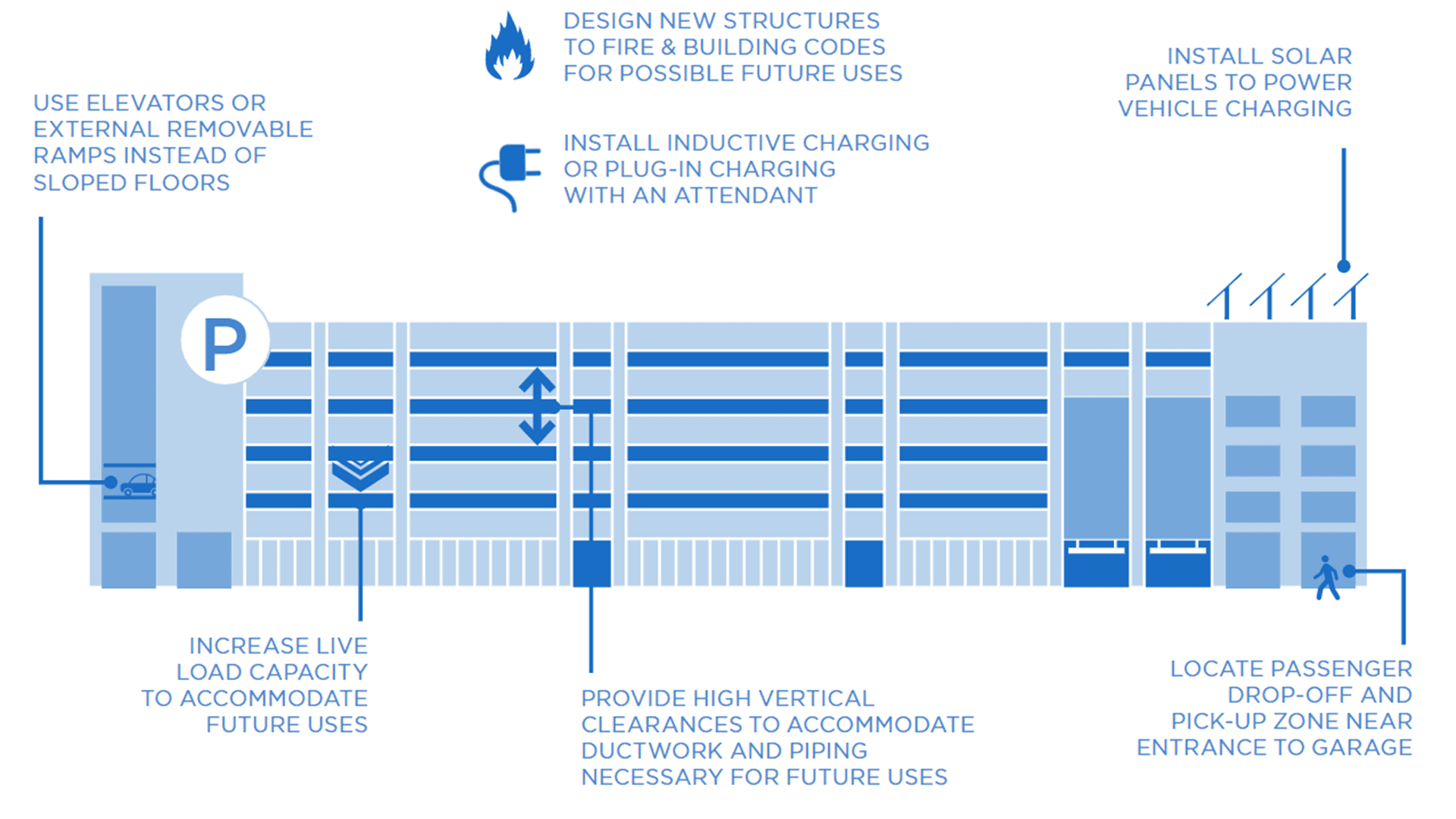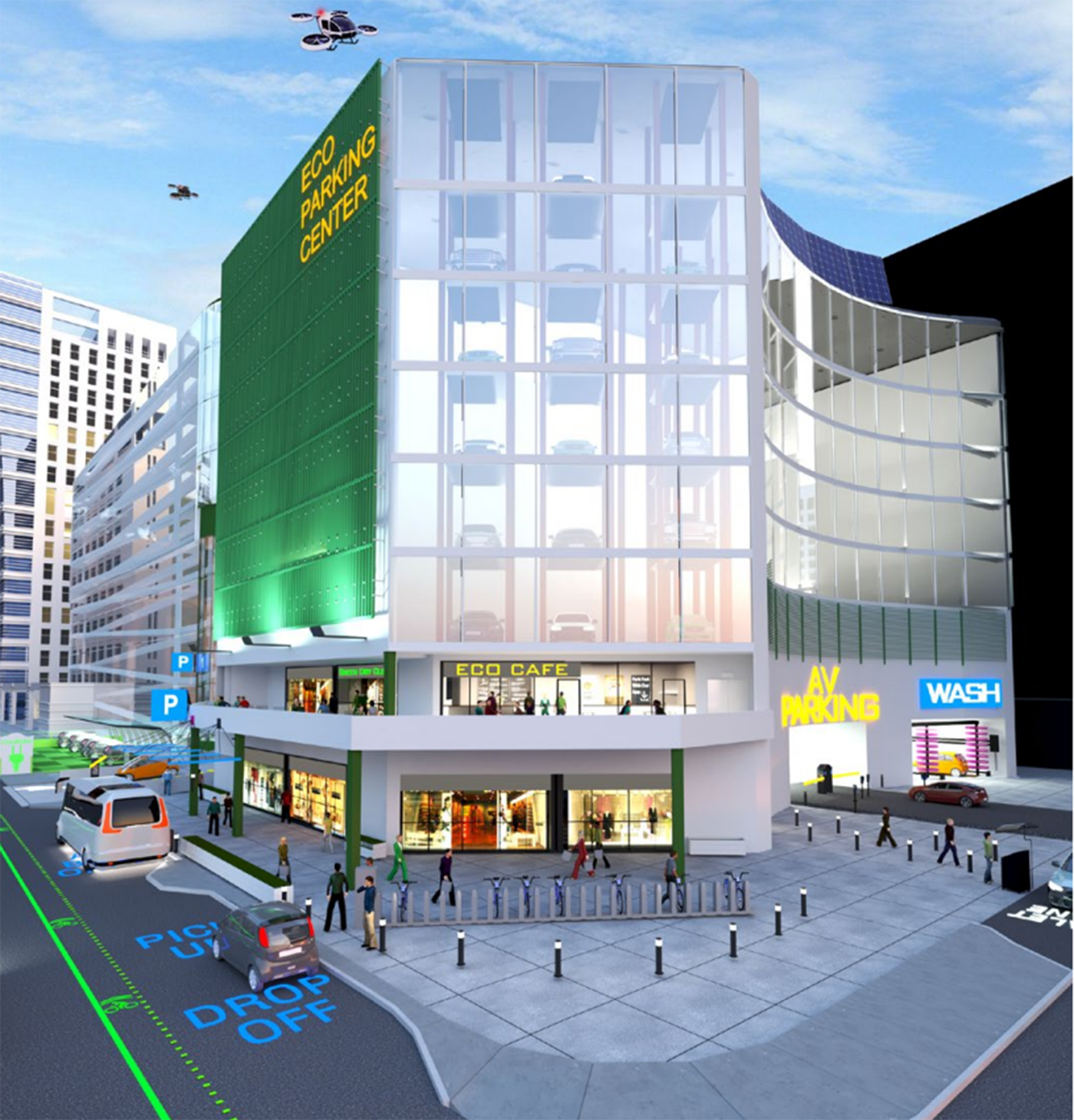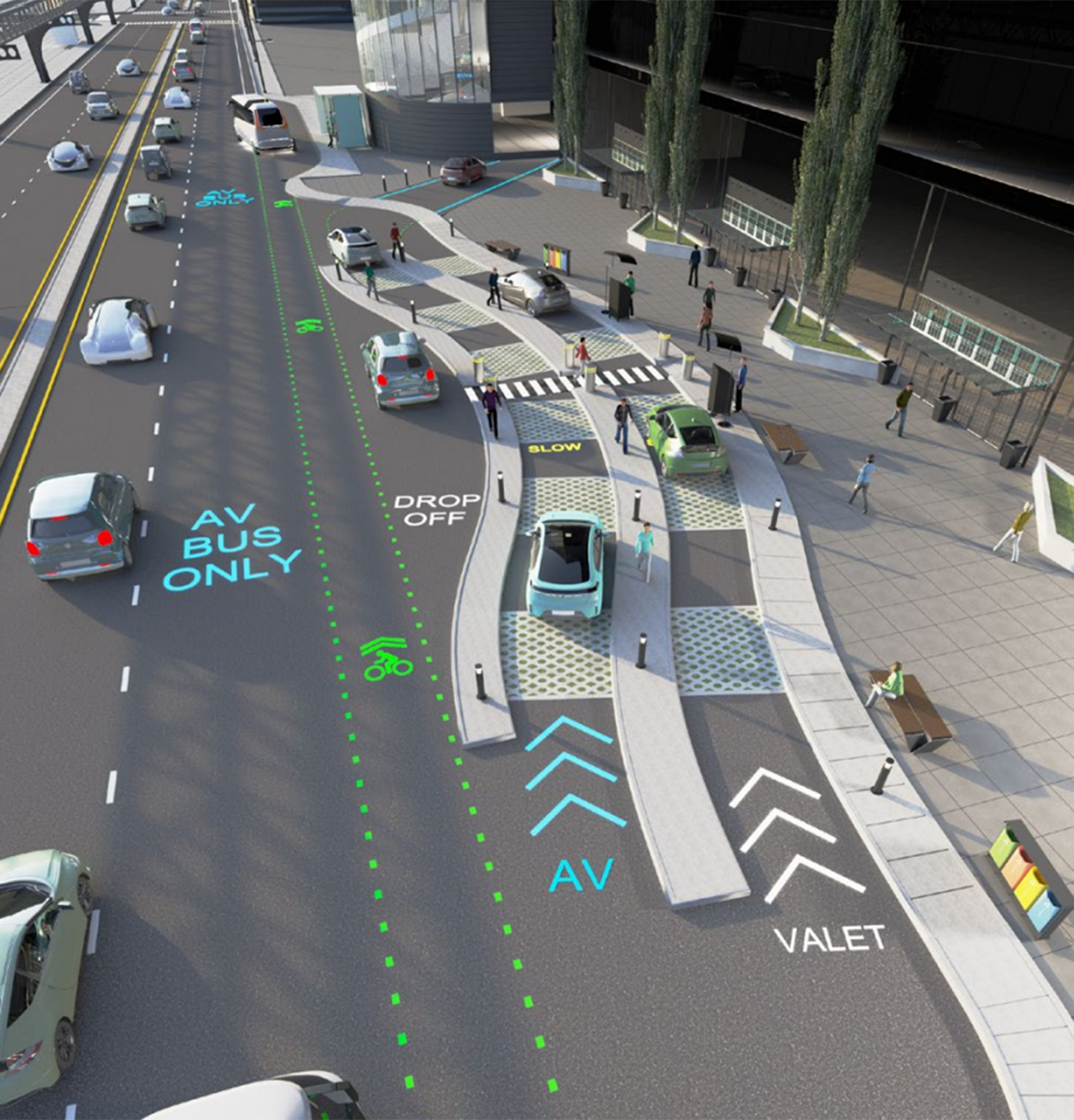December 14, 2018
Vehicle storage facilities are responding to a changing transportation network
There’s something different about a parking garage slated for construction in the Los Angeles Arts District.
The garage will have higher-than-normal ceilings. The floors will be flat, not slanted like traditional parking garages. Elevators and staircases will be placed in the middle, not the outside.
Why? Because one day, it won’t just be a parking garage.
Developer AvalonBay Communities, Inc. has plans to retrofit a portion of the garage to create shops, a gym, a theater, and other recreational activities once ride-sourcing decreases the rate of car ownership.
AvalonBay isn’t the only developer thinking ahead to a decrease in driving. Examples across the country – in cities like Houston, Nashville, and Seattle – tell us vehicle storage facilities are planning ahead to a day when parking garages take on new forms.
Transportation of the Future
We’re in the midst of a major transportation shift that’s changing the way we travel from place to place. The rise in ride-sourcing is re-shaping transportation systems as we know them. Ride-sourcing (including bikeshare) and micro mobility options like e-scooters make it easier to forego car ownership, which in turn could lead to a greater reliance on alternative modes.

People are turning to alternate modes of transportation, like e-scooters and ride-sourcing, to get from place to place. Photo: Luis Tamayo.
In addition, new transportation technologies – including automated vehicle (AV) technologies – have the potential to fuel the trend of decreasing car ownership (pun intended). If automated vehicles remove the driver from the equation, ride-sourcing costs could drop precipitously.
Experts debate the timeline of this mode shift, but they agree on one thing: ride-sourcing, micro mobility and AV technology will have a dramatic effect on transportation of the future.
As transformational technologies continue to decrease in cost and increase in popularity, we will see impacts not only on our transportation system, but also on the way we use land. Kittelson is leading a national research effort to develop NCHRP 8-117, the first guidebook of its kind helping transportation decision-makers better understand how transformational technologies can impact travel demand and land use.
Vehicle storage facilities are an important part of the discussion, since ride-sourcing has a direct effect on the need for traditional parking. If car ownership declines, traditional parking demand will drop too – possibly to as low as 10-15% of the current demand.
Additionally, the shift toward automated vehicles means cars will need less space in parking garages. Car owners using valet technologies will be able to remotely command their vehicles to open garage doors, enter, park themselves and shut down. Self-parking cars mean there is no need to open a car door in the garage, so parking spaces can be narrower.
So what will happen with the extra space?
Today a Garage, Tomorrow a Tennis Court?
Many developers see a future decline in parking demand as an exciting opportunity for infill – using the space in new ways. From entertainment spaces to office buildings, the potential future uses are many and varied.
- Andy Cohen, co-CEO of architecture firm Gensler, designed a fictional LA cultural center called “The MOD,” demonstrating the possible transformation of a parking garage into a variety of public uses.
- In Buffalo, New York, architect Sergio Lopez-Pineiro proposed the transformation of a parking garage into a sports facility including tennis courts and jogging tracks.
- Architecture firm Arrowstreet envisions future garage designs including solar paneled outer walls, rooftop greenspace, inductive floor charging panels, offices, recreation space, and entertainment space, along with a vehicle retrieval or passenger pick-up zone.
- Can you imagine living in a retrofitted parking garage? Some developers are preparing for vehicle storage facilities to become apartment complexes.
It’s not just structured parking garages that could drop in demand. Surface lots and parallel street parking also represent a blank slate for infill. A surface lot can become a park, an office building, an apartment, a bar, or a mixed-use development. On-street parking can become wider sidewalks, light-individual transport lanes for bikes and e-scooters, extensive planter strips and more.
Planning For the Future
Planning for transformations like these requires a different way of building.
You can't just throw down carpet and string up some lights to convert a space built for cars into one for humans, whether as housing, office space, or retail. It calls for a different way of building a parking garage.
- Aarian Marshall, Wired
Today’s designs need to account for future retrofits. Vertical clearances should be high enough to be retrofitted with duct work and piping and still be comfortable in a new use, such as an office or apartment building. Live load capacity and fire codes need to adhere to office/residential standards, which are typically more rigorous than parking garage standards. Sloped floors and office chairs are unfortunately not compatible – so floors should be flat, with elevators or ramps included to take vehicles from one floor to the next.

Image: “Effects of Emerging Vehicle Technologies on Land Use & Development,” Kittelson & Associates.
These design considerations will enable maximum future utility in a future day when extra space is transformed to new uses.
Changes We’re Seeing Today
Yes, it may be decades before parking garages turn into apartment complexes. But today’s changing transportation systems are already impacting parking garages as we know them. To prepare for the future, the National Parking Association (NPA) is working with garage operators to embrace more modes of transportation, recognizing garages won’t always be used for just storing vehicles. The NPA has even begun rebranding vehicle storage facilities as “mobility hubs.”
The whole view of the function of streets has had a metamorphosis. It's made us rethink the opportunity cost of plopping a parking garage in prime downtown property.
- Joe Schwieterman, Professor of Transportation at DePaul University, Pew Trusts
“Mobility hubs” is a broad term that describes the shift from simply storing vehicles to creating spaces for all these modes of transportation. This includes sectioning off storage for bicycles, adding stations for bike and e-scooter shares, and building in safe and efficient spaces for ride hailing vehicles and public transit operators to pick up and drop off passengers. This will only increase as ride-sourcing networks increase in popularity, and communities look to meet the mobility needs of all roadway users.
In 2017, the New York Times announced that the city of New York had more bike commuters on the streets than drivers. Cities like New York are taking a hint from the Netherlands, who currently have the world’s largest bicycle storage facility. (Video credit goes to Kittelson Associate Planner Conor Semler, who managed to record while riding his bike!)
In addition, development of mobility hubs also has curbside management and street design implications. 62 percent of respondents to the 2018 Emerging Trends in Parking survey point to the explosive growth of ride-hailing/transportation network companies as a societal change influencing parking. The competition for curbside space continues to intensify with increasing demands from delivery vehicles and ride-hail services, and the need to identify strategies for separating bikes and ride-source vehicles remains a priority. The NPA envisions new ways of using curbside space at mobility hubs to account for the increasing ride-sourcing demand:


The shift from parking garages to mobility hubs as road users increasingly embrace alternative modes of transportation. Images: Smart Solutions for Shared Mobility, National Parking Association.
More and more, we expect to see vehicle storage facilities embrace a wider range of mobility needs.
What’s Next?
We live in a world where there’s fierce competition for that open parking spot, but it’s essential that developers think ahead to adapting parking garages to future needs and uses. The lifespan of parking garage is several decades – so it’s important we prepare for the future today.
Every day, the transportation profession is growing in our understanding of the impacts of vehicle automation, ride-sourcing, and other emerging transportation methods. “Be passionately curious” is one of our core values at Kittelson, and we recognize the vitality of being part of the discovery. We’re partnering with leading research organizations across the country to find answers to complex questions.
The first of NCHRP’s guidebooks on transformational technologies is scheduled for publication in 2019. Kittelson is excited for the chance to help decision-makers plan for the future, while taking care of the present. You can learn more about this project here.
